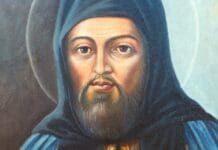By Phillip Rolfes
It was 2009 or 2010. I was in the recording studio at Eastern Christian Publications/Orientale Lumen Television in Fairfax, VA, setting up cameras, adjusting lighting, and syncing up the sound. I’d been tasked with filming, editing, and producing a series of Adult Enrichment videos about the icons of the Great Feasts.
My guest: Professor Richard Schneider—professor of iconology at Saint Vladimir’s Orthodox Theological Seminary in Yonkers, NY.
Over the course of a week, Professor Schneider immersed me in the world of symbols, colors, history, theology, spirituality, and liturgy that gave birth to these icons. It was through him that I learned how iconography isn’t merely “religious art,” but rather “liturgical art.” Nor are they “windows” through which we passively peer into heaven. Rather they are liturgical doorways that we must learn to walk through in order to participate in the mysteries they represent in signs, symbols, and colors.
By the end of the week, I felt like I’d been on a private retreat. And I was only too happy to repeat the experience as I edited the videos into a multi-part packaged series for our Adult Enrichment programs.
Signs and Symbols
When you enter the world of iconography, you enter a world of signs, symbols, and colors. In many ways, you enter a very “sacramental’ world. The signs and symbols you encounter in icons point to realities outside of themselves and, in a mediated way, even make those realities present.
So, before we can begin interpreting the icon of Christ’s “Harrowing of Hades” itself, let’s first review a few basic symbols you’ll inevitably encounter.
Greek Abbreviations
If you’re looking at Byzantine iconography (which is what we’re examining here), you’ll need to know a little Greek. There are three Greek abbreviations in particular that you’ll frequently encounter:
- ICXC NIKA—The first part here, IC XC, contains the first and last Greek letters for the name Iesus Cristus, Jesus Christ. NIKA means “conquers.” So the symbols taken together mean “Jesus Christ conquers.” This symbol is very common in any icon that depicts Christ.
- O-W-N—This phrase appears in Jesus’ halo whenever He is depicted. The Greek Ό ΏΝ comes from Exodus 3:14 where God tells Moses, “I am who I am… Say this to the people of Israel, ‘I am has sent me to you.'” Jesus is the One-Who-Is, and we paint this phrase into His halo to remind us of that truth.
- MP ΘV—Another abbreviation (as indicated by the little squiggly line you’ll see above the letters in the icon). These letters are always painted to the left and right of Mary whenever she is depicted. They stand for Meter Theou or “Mother of God.” In the East it’s understood that the highest title and greatest honor we can give Mary is to call her the Mother of God (as defined at the Ecumenical Council in Ephesus).
Those are the abbreviations and phrases that will appear most commonly in Greek, although they are sometimes written in Church Slavonic.
Mandorla and Aureola
The aureola is a special type of halo that indicates a powerful manifestation of God’s glory—usually an image that shows the divinity of Christ in a particular way. Like the halo, the radiance originates within the person being depicted, and then radiates outward. But unlike the halo, the aureola encircles the entire body of the One being depicted as a symbol of His divinity. It’s most commonly seen in icons of the Resurrection, Ascension, and Transfiguration of our Lord, but sometimes appears in other icons as well.
As a symbol of divinity, the aureola is reserved for images of the Trinity, our blessed Lord, or the Holy Spirit (God the Father is not traditionally depicted in iconography because “no one has seen the Father” [Jn 6:46]). But because of her close connection to the Word-Made-Flesh, an aureola also appears in images of the Dormition of the Mother of God as her divine Son descends from heaven to welcome her into eternal life.
A sub-type of aureola, the mandorla is an almond-shaped aureola. It most commonly appears in icons of Christ’s “Descent into Hades” (as we’ll see in the next post) and the “Dormition of the Mother of God.” However, there is no real symbolic difference between the aureola and the mandorla.
My personal favorite example of an aureola is in the Russian iconographer Rublev’s image of “Christ Enthroned”—the image at the beginning of this article.
When I lived in Ann Arbor, MI, I attended the Catholic charismatic parish that my wife grew up in. They had a Perpetual Adoration chapel with this image hanging behind the Blessed Sacrament. I often felt bad for spending my time admiring the icon rather than adoring Christ present in the Eucharist.
Colors
As you can imagine, the choice of colors also plays a significant role in iconography. Certain colors are meant to remind us of certain realities. That being said, it’s possible to read too much into colors. Sometimes a color is just a color. Trees are green in icons because they are green in the world. Dirt is brown in icons because dirt is brown in the world.
Here are the basic colors and their symbolism that you should know:
- Gold
Gold (or yellow) is symbolic of God’s glory. In many icons the entire background will be either layered in gold leaf or painted yellow to remind us that God is “present in all places and filling all things.” - White
White is the color of light and purity. It’s most often used for icons of Christ after His Resurrection or during His Transfiguration. It’s also used for angles as a symbol of their purity. - Red
Red has a dual meaning. On the one hand it represents Christ’s divinity, and is also used to show Mary’s participation in God’s divine nature. Since Mary is the model of Christian life, this reminds us that we are all called to participate in the divine nature, just as she does. Easterners call this “theosis.” Red also symbolizes blood and is used in images of the martyrs. - Blue
Blue is often used when gold and yellow are not. It can symbolize the heavens. But it also indicates our humanity. Christ is sometimes depicted wearing blue underneath a red covering to show that he took on our human nature while remaining divine. - Green
Green is the color of the Holy Spirit who is “Lord and Giver of Life.” The Prophets are often depicted wearing green to show that it was the Holy Spirit who spoke through them.
The Two Axes
The last thing we’ll talk about before interpreting the icon of the “Harrowing of Hades” are the two axes that organize the thought and themes of an icon.
Icons are organized around the cross. In other words, there is a vertical axis and a horizontal axis. The main character(s) in the story being depicted is typically painted at the point where the vertical axis and the horizontal axis meet.
The vertical axis is the central axis that reveals the main character(s) and also the primary action of the story. The horizontal axis, on the other hand, emphasizes the central action, but also draws attention to the secondary characters who shed further light on the main character and the main action.
Okay! Now that we know the meanings of the basic colors and symbols that appear in icons, let’s get into some interpretation…
 Phillip Rolfes is That Eastern Catholic Guy. A “canonical convert” from Roman Catholicism to Maronite Catholicism, Phillip loves researching and sharing the rich traditions of the Christian East. He lives in Cincinnati, OH. with his wife and four children, and is parishioner at St. Anthony of Padua Maronite Catholic Church.
Phillip Rolfes is That Eastern Catholic Guy. A “canonical convert” from Roman Catholicism to Maronite Catholicism, Phillip loves researching and sharing the rich traditions of the Christian East. He lives in Cincinnati, OH. with his wife and four children, and is parishioner at St. Anthony of Padua Maronite Catholic Church.


















Make 6150 bucks every month… Start doing online computer-based work through our website. I have been working from home for 4 years now and I love it. I don’t have a boss standing over my shoulder and I make my own hours. The tips below are very informative and anyone currently working from home or planning to in the future could use this website……… Details Here